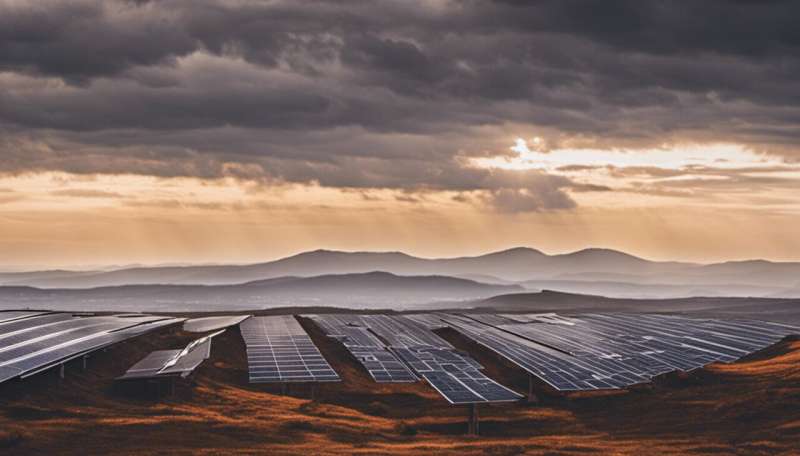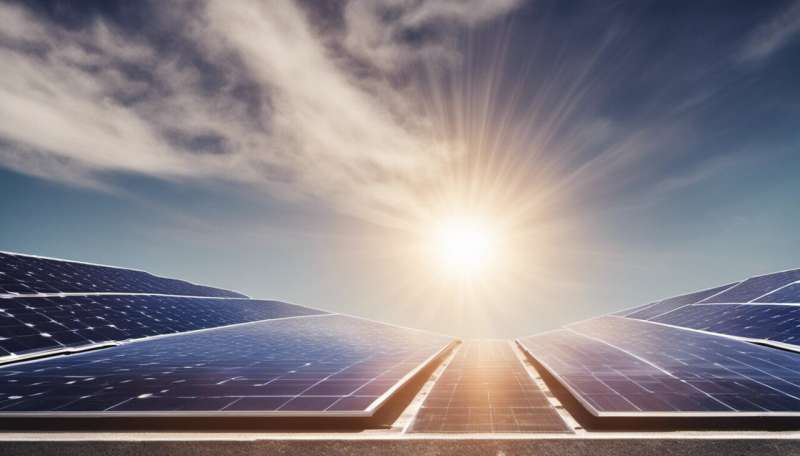This article has been reviewed according to Science X's editorial process and policies. Editors have highlighted the following attributes while ensuring the content's credibility:
fact-checked
peer-reviewed publication
trusted source
written by researcher(s)
proofread
Solar panel technology is set to be turbo-charged—but first, a few big roadblocks have to be cleared

Solar panel technology has made enormous progress in the last two decades. In fact, the most advanced silicon solar cells produced today are about as good as the technology will get.
So what's next? Enter "tandem solar cells," the new generation in solar technology. They can convert a much greater portion of sunlight into electricity than conventional solar cells.
The technology promises to fast-track the global transition away from polluting sources of energy generation such as coal and gas. But there's a major catch.
As our new research published in Energy & Environmental Science shows, current tandem solar cells must be redesigned if they're to be manufactured at the scale required to become the climate-saving technology the planet needs.
The solar story so far
A solar cell is a device that turns sunlight into electricity. One important measure when it comes to solar cells is their efficiency—the proportion of sunlight they can convert into electricity.
Almost all solar panels we see today are made from "photovoltaic" silicon cells. When light hits the silicon cell, electrons inside it produce an electric current.
The first silicon photovoltaic cell, demonstrated in 1954 in the United States, had an efficiency of about 5%. That means that for every unit of the sun's energy the cell received, 5% was turned into electricity.
But the technology has since developed. At the end of last year, Chinese solar manufacturer LONGi announced a new world-record efficiency for silicon solar cells of 26.81%.
Silicon solar cells will never be able to convert 100% of the sun's energy into electricity. That's mostly because an individual material can absorb only a limited proportion of the solar spectrum.
To help increase efficiency—and so continue to reduce the cost of solar electricity—new technology is needed. That's where tandem solar cells come in.
A promising new leap
Tandem solar cells use two different materials which absorb energy from the sun together. In theory, it means the cell can absorb more of the solar spectrum—and so produce more electricity—than if just one material is used (such as silicon alone).
Using this approach, researchers overseas recently achieved a tandem solar cell efficiency of 33.7%. They did this by building a thin solar cell with a material called perovskite directly on top of a traditional silicon solar cell.

Traditional silicon solar panels still dominate manufacturing. But leading solar manufacturers have signaled plans to commercialize the tandem cell technology.
Such is the potential of tandem solar cells, they are poised to overtake the conventional technology in coming decades. But the expansion will be thwarted, unless the technology is redesigned with new, more abundant materials.
The problem of materials
Almost all tandem solar cells involve a design known as "silicon heterojunction." Solar cells made in this way normally require more silver, and more of the chemical element indium, than other solar cell designs.
But silver and indium are scarce materials.
Silver is used in thousands of applications, including manufacturing, making it highly sought after. In fact, global demand for silver reportedly rose by 18% last year.
Likewise, indium is used to make touchscreens and other smart devices. But it's extremely rare and only found in tiny traces.
This scarcity isn't a problem for tandem solar technology yet, because it hasn't yet been produced in large volumes. But our research shows this scarcity could limit the ability of manufacturers to ramp up production volumes in future.
This may represent a substantial roadblock in tackling climate change. By mid-century, the world must install 62 times more solar power capacity than is currently built, to enable the clean energy shift.
Clearly, a major redesign of tandem solar cells is urgently needed to enable this exponential acceleration of solar deployment.
Ramping up the transition
Some silicon solar cells don't use indium and require only a small amount of silver. Research and development is urgently needed to make these cells compatible with tandem technology. Thankfully, this work has already begun—but more is needed.
A scarcity of materials is not the only barrier to overcome. Tandem solar cells must also be made more durable. Solar panels we see everywhere today are generally guaranteed to produce a decent amount of electricity for at least 25 years. Perovskite-on-silicon tandem cells don't last as long.
Solar power has already shaken up electricity generation in Australia and around the world. But in the race to tackle climate change, this is only the beginning.
Tandem solar cell research is truly global, conducted within a range of countries, including Australia. The technology offers a promising way forward. But the materials used to make them must be urgently reconsidered.
More information: Matthew Wright et al, Design considerations for the bottom cell in perovskite/silicon tandems: a terawatt scalability perspective, Energy & Environmental Science (2023). DOI: 10.1039/D3EE00952A
This article is republished from The Conversation under a Creative Commons license. Read the original article.![]()

















